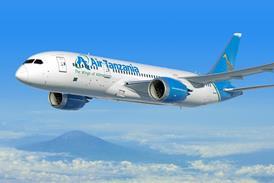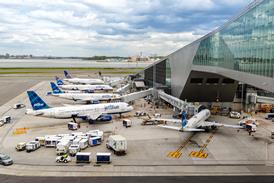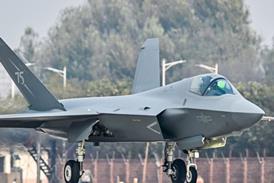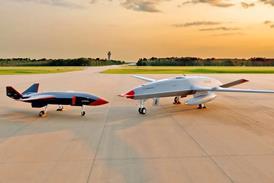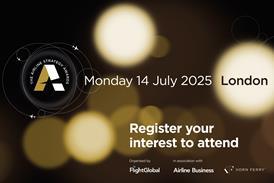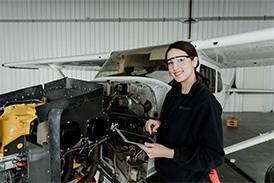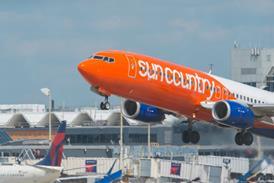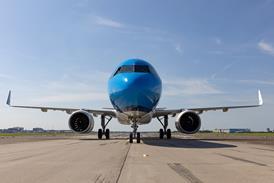The new chief executive of air taxi start-up Wisk Aero thinks he has the aircraft-development experience needed to lead the company’s transition, now underway, into the critical phase of flight testing and certification.
“I have 20 years of experience developing new aerospace products, in the US, in Canada, in Europe,” Sebastien Vigneron, who recently succeeded Brian Yutko as CEO of the Boeing-owned, Mountain View, California-based company, tells FlightGlobal. “I’ve covered the entire product-development life cycle, from a clean sheet… through detailed design, build, test, certification, entry into service.”
Vigneron, an aerospace engineer by background, takes Wisk’s reins following a career that included years working on business and commercial aircraft development products at Dassault Aviation and Bombardier. He also worked at another transportation start-up, now-defunct Virgin Hyperloop.
Wisk revealed the CEO transition on 7 May. Yutko, who had worked at Boeing before becoming Wisk CEO since 2023, has returned to Boeing to be vice-president of product development for the company’s Boeing Commercial Airplanes division.

Vigneron, asked about his leadership style, says, “I bring a good blend of the rigour and discipline of aerospace product development and [of] certification… I am able to navigate both sides of that world, and I’m able to maintain the right balance.”
“I always assume good intent, and I believe in the people,” he adds. “I work for my team. I support my team. And I do everything I can so that they can be successful.”
Vigneron calls the CEO shift “a natural evolution” coming as Wisk prepares to transition to flight testing its prototype Generation 6 autonomous electric vertical take-off and landing (eVTOL) aircraft.
“The timing is good, because we’re about to enter a new phase,” Vigneron says. “As we get ready to enter first flight, it makes sense to make a change.”
He adds that the CEO transition does not reflect any shift to Wisk’s broader strategy, saying, “The mission is not changing. The game plan is not changing”.
Wisk has flown several eVTOL designs in recent years but is now inching closer to beginning flight tests of its Gen 6 prototype – the variant it aims to bring through certification.
“We are a few months away from flying. We are driving towards flying over the summer,” Vigneron says. “We’re still aiming at certifying before the end of the decade.”
The Gen 6 air taxi will carry four passengers, have 78nm (145km) of range, fly at 110-120kt (204-222 km/h) and charge in 15min, Wisk says. The aircraft has fixed wings and 12 propellers mounted in pairs on wing-mounted booms. All 12 propellers produce lifting thrust, while the forward six props also rotate to provide forward thrust. While pilotless, the air taxis are monitored by humans on the ground.
While doubters question if battery technology has advanced sufficiently to enable high-frequency, taxi-like flights, Vigneron insists the electric-propulsion technology is up to the task.
“We’ve reached a threshold that enables eVTOL operations,” he says.
A native of Paris, France, Vigneron has degrees in mechanical engineering and aeronautics and spent the early part of his career – six years in total – at Dassault Aviation, where he worked on the Falcon 5X, 6X and 7X programmes, including as aerodynamics group lead.
He also led aerodynamics for that company’s supersonic business jet research programme, and contributed to the Solar Impulse programme to develop a solar-powered experimental aircraft – a project that spurred Vigneron’s interest in innovating new types of aerospace products.
He moved to Bombardier in 2011, where he spent eight years and contributed to the CSeries (now called the Airbus 220) commercial aircraft programme and Bombardier’s Global business-jet programmes.
“I went through the entire development programme of the Global 7500 – literally, from A to Z,” says Vigneron. He remembers, early during that programme, “Changing the wing [design] on a piece of paper”.
Bombardier achieved the Global 7500’s certification in 2018. Vigneron then took a job with Virgin Hyperloop, which had been developing a high-speed passenger transportation system involving a magnetically levitated vehicle travelling inside a tube.
“I was very much attracted by the prototyping mindset, pushing the boundaries, bold innovation, quick iteration, learning by doing,” says Vigneron.
He joined Wisk in 2021 and was most recently its head of product development.
Like other eVTOL developers, Wisk faces a tall task in bringing an aircraft as novel as its Gen 6 through certification.

But Wisk and its competitors at least now have a roadmap. The Federal Aviation Administration last year issued both a rule defining air taxi operational and pilot-training requirements and an advisory providing guidance for certificating air taxis under existing airworthiness regulations.
“It’s laying out the path for certification… It’s all going in the right direction,” Vigneron says.
And while regulators have never approved types like eVTOLs before, Vigneron says the certification process – specifically, the certification “guiding principles” – are the same as for conventional aircraft.
“The principles we need to follow exactly, and the methodology, is the same,” he says. “How do we show compliance to those things? That’s where the challenge is.”
Hollister, California, which is south of San Francisco, is where Wisk is prepping its Gen 6 eVTOL for first flight. There, the team is putting the prototype’s batteries, propulsion system, software and other components through a series of tests.
The company’s system integration test rigs are “firing on all cylinders”, says Vigneron. “We are deep into the weeds of safety-of-flight testing right now.” Meanwhile, Wisk is also conducting aerodynamic evaluations of a subscale Gen 6 model at Boeing’s V/STOL Wind Tunnel facility in Philadelphia.
Those wind-tunnel tests will last several months, Vigneron says. “We are going to be doing a lot of endurance testing, durability testing… We need to get a lot of hours under the belt.”
Wisk operates “completely independently from Boeing” but has access to some of the aerospace giant’s resources, such as the wind-tunnel facility, Vigneron says. Wisk has also been “leveraging [Boeing’s] manufacturing capabilities in the Seattle [and] in the Mesa area, for so many different components”.
The CEO says Boeing benefits, too.
“We are exploring new ways of doing product development, new ways of running a development programme,” Vigneron says. “We bring all those learnings back to Boeing, and that’s why the connection with Boeing product development makes sense. We are learning from each other.”
ALL IN ON AUTONOMY
Most of Wisk’s competitors – Joby Aviation, Archer Aviation, Eve Air Mobility, Beta Technologies – are developing air taxis that will, initially at least, be controlled by an onboard human pilot.
But Wisk is undertaking the more-ambitious goal of developing and certifying an autonomous air taxi from the start.
“It’s the only way we can scale… If we want to have a lot of those aircraft up in the air, there is no other way,” says Vigneron. “Also… that is the only way the business case actually makes sense.”
He says autonomy will enable air taxis to be economically viable; operators will not incur the cost of employing pilots, and pilotless aircraft have room for one more paying passenger. “It’s very obvious to see that we need to go toward autonomy,” Vigneron says.

